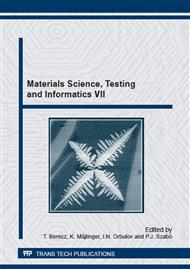[1]
B. C. Matsuddy, Ceramic injection molding, Chapman and Hall, (1995).
Google Scholar
[2]
B. Hausernova, L. Marcanikova, Rheological characterization of powder injection molding using feedstock based on aluminum oxide and multicomponent water-soluble polymer binder, Proceedings of Recent Advances in Fluid Mechanics and Heat & Mass Transfer, (2011).
DOI: 10.1002/pen.21928
Google Scholar
[3]
V. A. Krauss, E. N. Pires, A. N. Klein, Rheological properties of alumina injection feedstocks, Materials Research, 8, 2 (2005) 187-189.
DOI: 10.1590/s1516-14392005000200018
Google Scholar
[4]
Z. S. Rak, New trends in powder injection molding. Powder Metallurgy and Metal Ceramics, 38, (1999) 126-132.
DOI: 10.1007/bf02676037
Google Scholar
[5]
W. C. J. Wei, R. Y. Wu, S. J. Ho, Effects of pressure parameters on alumina made by powder injection molding, Journal of the European Ceramic Society, 20 (2000) 1301-1310.
DOI: 10.1016/s0955-2219(99)00295-2
Google Scholar
[6]
H. Q. Yin, C. C. Jia, X. H. Qu, Micro powder injection molding—large scale production technology for micro-sized components, Science in China Series E: Technological Sci., 51 (2) (2008) 121-126.
DOI: 10.1007/s11431-008-0023-y
Google Scholar
[7]
W. H. Gitzen, Alumina as a ceramic material, The American Ceramic Society, 11 (1970) 68-78.
Google Scholar
[8]
G. L. Messing, W. McCauley, K. S. Mazdiyasni, R. A. Haber, Advances in ceramic, ceramic powder science, The American Ceramic Society, 21 (1987) 198-207.
Google Scholar
[9]
F. Filser, L. J. Gauckler, Keramische Werkstoffe, Kapitel 4: 4 Beispiele für strukturkeramische Werkstoffe, ETH-Zürich, Department Materials, (2006).
Google Scholar
[10]
J. Tamásné Csányi, Alumínium-oxid porkerámiák alakadási technológiai paramétereinek optimalizálása, különös tekintettel a mechanikai tulajdonságokra és a mikroszerkezetre, PhD értekezés, Miskolc, (2007).
Google Scholar
[11]
S. Shiegeyuki, Handbook of advanced ceramics, Amsterdam, Elsevier. 1. (2003) 365-369.
Google Scholar
[12]
J. Enrique, E. Ochandio, M. F. Gazulla, Chemical analysis, in engineered materials handbook, ASM International, Materials Park, OH. 4 (1997) 125-138.
Google Scholar
[13]
J. E. Funk, D. R. Dinger, Particle Packing, Part 2. Review of particle packing of polydisperse particle system, Interceram, 41 (3), (1992) 176-179.
Google Scholar
[14]
F. Stringer, S. Mende, Nanomilling in stirred media mills, Chemical Engineering Science 60 (2005) 4557-4565.
DOI: 10.1016/j.ces.2005.02.057
Google Scholar
[15]
W. Paukert, Material properties in fine grinding, Int. J. Miner. Process. 74 (2004) 3-17.
Google Scholar
[16]
H. Barth, Modern methods of particle size Analysis, Wiley-Interscience, New York, (1985).
Google Scholar
[17]
T. Allen, Particle size measurement, Wiley-Interscience, New York, (1981).
Google Scholar
[18]
S. Serkowski, M. Müller, Vacuum granulation of ceramic powders – Device and ability, Journal of Materials processing Technology 5 (2005) 458-471.
DOI: 10.1016/j.jmatprotec.2005.04.065
Google Scholar
[19]
S. Lowell, J. Shields, Powder surface area and porosity, Chapman and Hall, New York, (1984).
Google Scholar
[20]
L. Cotica, F. Paesano, High energy ball-milled (Fe2O3) (Al2O3) system: A study on milling time effects, Journal of Alloys and Compound, 24 (2005) 45-54.
Google Scholar
[21]
B. C. Matsuddy, Influence of powder characteristics on the rheology of ceramic injection molding mixtures, Fabrication Sci., 3, Proc. Brit. Ceram. Soc., (1983) 117-137.
Google Scholar
[22]
M. J. Edirisinghe, J. R. G. Evans, Rheology of ceramic injection molding formulations, Ceram. Trans. J. 86 (1987) 18-23.
Google Scholar
[23]
T. Tanaka, Injection molding of alumina, Yogyo-Kyokai-shi, 93 (1985) 572-576.
Google Scholar
[24]
M. J. Cima, J. Lewis, Binder distribution in ceramic greenware during thermolysis, New York, (1989).
Google Scholar
[25]
J. Csányi, Rheological characteristics of alumina powders in dry pressing technology, Építőanyag, 61 (1), (2009) 6-10.
DOI: 10.14382/epitoanyag-jsbcm.2009.2
Google Scholar


